By Rebecca Vittetoe
While the cooler and snowy weather may have limited field activities last week, farmers are getting back to the fields across the state this week, with many getting started on planting. Iowa State University Extension and Outreach field agronomists share reports on what they are seeing and hearing in their respected regions across the state with field conditions and planting progress.
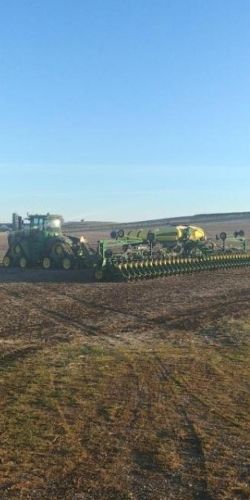
North Central Iowa
Angie Rieck-Hinz (Region 3): “Soil conditions have been really variable across North Central Iowa, lending to some areas that are ready to plant and others still too wet and too cool to plant. Planting started as early as April 1, or so some rumors have it, some around April 8, but this past weekend I saw a lot of field work and planting really starting in earnest. Soil temperature (4-inch depth) is one of the key factors used to determine if conditions are fit for planting. Ideally, we like soil temperatures at the 4-inch depth to be 50 degrees F and rising. You may wonder why do we measure soil temperature at 4 inches rather than planting depth say at 2 or 2.5 inches? One reason is that we see less diurnal (ups and downs based on air temperature) swings at the 4-inch depth. The shallower we take the soil temperature, the more erratic it will be from warmer temperatures during the day and cooler temperatures at night. Over the weekend I was checking soil temperatures, and the photo below was taken at 12:50 p.m. on Saturday, April 18 and shows the 4-inch soil temperature was only 43 degrees F at Story City; however just 15 miles north of Story City, the 4-inch soil temperature was at 49 degrees F. This difference was mostly due to the recent snow event that happened on April 17 that hit Story City but not further north. Wetter soils take longer to warm. With some corn being in the ground last week with the cooler conditions, it will be interesting to see what impacts may occur if that seed had already imbibed water and started to germinate. It is all about risk and reward. Do you plant earlier to maximize yield potential, but risk planting in less than ideal conditions, which could lead to stand loss and hurt the yield potential?”
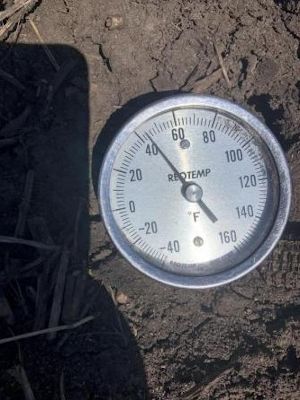
Central Iowa
Meaghan Anderson (Region 7): "While corn and soybean planting started in earnest in early April in some parts of central Iowa, the cold and snow last week brought a lot of work to a halt. I scouted some fields last week and the one constant was winter annuals and even some summer annuals emerged and waiting for a herbicide application or tillage pass; most species seemed minimally affected by the cold temperatures. I found horseweed (marestail), field pennycress, henbit, dandelion, common lambsquarters, common ragweed, field horsetail, and scouring rush during my quick walk. Farmers with crops planted before the cold snap will want to keep a close eye on crops as they emerge to look for potential issues from exposure to the cold, wet soils like imbibitional chilling. Fieldwork started again late last week, and field conditions are excellent across most of my area for planting, tillage, and spraying. I saw 5 planters and 4 field cultivators at work during a drive Monday (4/20) afternoon and the 4-inch soil temperature in Boone County was just under 52 degrees F. I am hopeful for good planting conditions for all the farmers before the next rainfall! Questions I have received in the last week include hay planting, Equisetum control near crop fields, and herbicide program planning following prevented plant.”
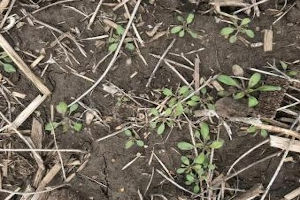
Southwest and West Central
Mike Witt (Region 6): “Farmers in western Iowa will be planting and applying herbicides this week with the weather window and the opportunities to get started. Soil conditions vary considerably with soil types if they are fit for field work. A main concern is the cool wet soils with temperatures in the upper 40’s, especially for those wanting to start planting. Optimal soil temperatures (at 4-inch depth) should be 50 degrees F and increasing. Planting into cooler and wetter soils leads to concerns about stand loss from imbibitional chilling, slower emergence, potential seedling diseases, and compaction. Cutting corners early in a rush to plant may come back to haunt a farmer all year. Cover crops look good around the region with rye averaging around 5 to 8 inches in height depending upon planting date last fall. The pictures display rye aerial applied on the ISU Western Research farm in Castana, IA in early August 2019. Overall this week is a good week to get some field tasks done but proceed with caution.”
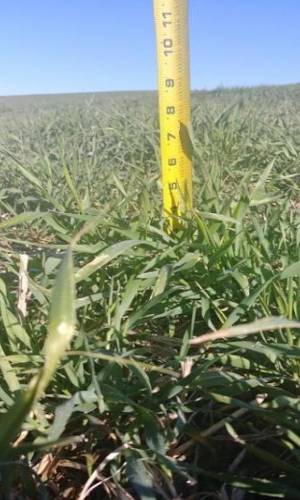
East Central, Southeast, and South Central:
Rebecca Vittetoe (Region 8): “As fields are drying out and warming up after the cold and snowy weather last week, field activities are picking back up. I saw a little bit of everything today from fertilizer applications, spraying, and planters starting to roll. Do keep an eye on fields as the winter annual weeds like chickweed, field pennycress, horseweed (marestail) are doing quite well. I have seen and heard of a little damage to cover crops and some forages with last week’s colder weather; however, what I’ve seen does appear to mainly be cosmetic. Questions I’ve had the past week have mainly been on soil temperatures and planting, cover crop termination, and spring forage management.”
Virgil Schmitt (Region 9): “In general, we’ve had between one and two inches of rain with some areas reporting between two and three inches of rain over the past two weeks. There was some hail on April 8, but damage was mostly confined to vehicles. Over the last two weeks, there has been quite a bit of fertilizer, tillage, and burn down spraying done. Oats and forage planting is pretty much complete. There has been some corn planted south of Highway 30 as well as quite a few acres of soybeans along and south of Highway 34. In the big picture, less than 5% of either crop has been planted across my region; however, I think there will be a lot of planting activity this week if the rains stay away The colder weather did little damage to cover crops, perennial crops, or to weeds in general. Mustards, dandelions, and purple dead nettle are blooming. Questions have mainly been on fertilizer applications and planting.”
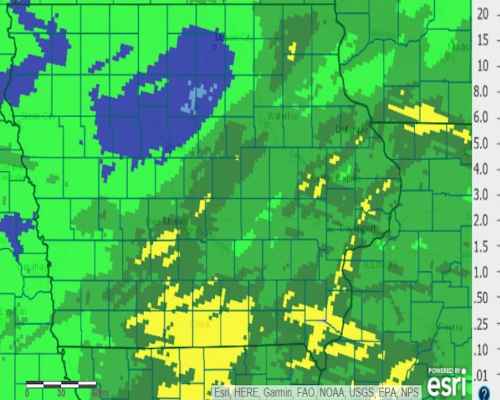
Josh Michel (Region 11): “Fieldwork started early last week throughout most of southern and southeast Iowa. This included fertilizer applications, field prep, and even some planting in a few small areas. The recent snowfall and cold temperatures slowed and halted fieldwork. With patience, soil conditions should be fit for field work and planting by the end of the week in most areas. Cool season grasses in pastures are beginning to green up, and cover crops are doing well. So far, there have been very few reports of any winterkill in alfalfa fields across my region. Recent questions have included: winter annual spraying, cover crop termination, cover crop grazing, fertilizer management, soil temperatures, and planting considerations.”
Check out the map below to find your local ISU Extension field agronomist and find their contact information here!
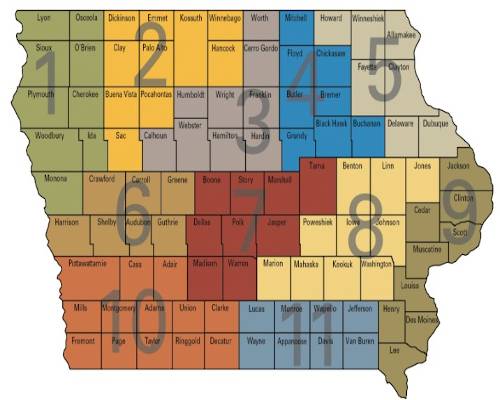
Source : iastate.edu